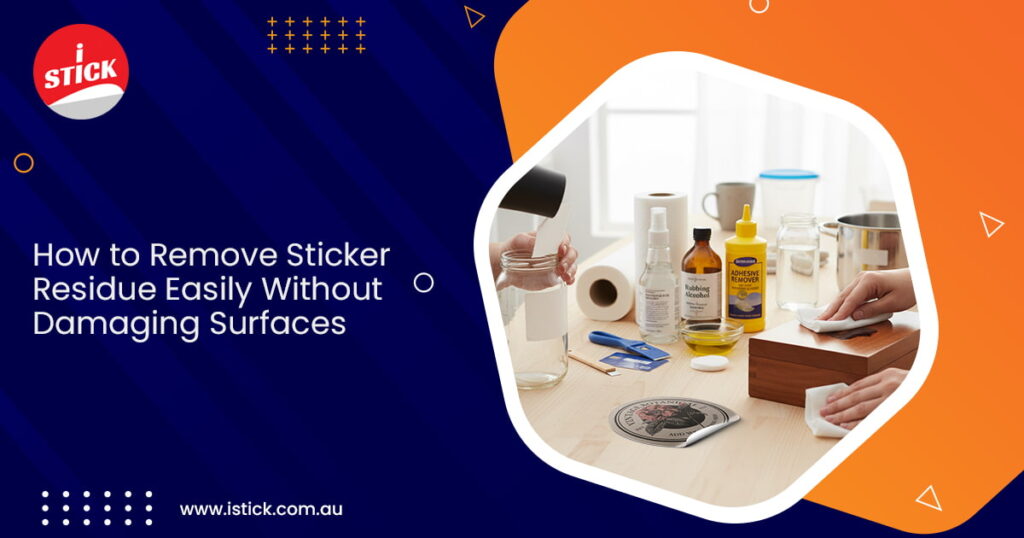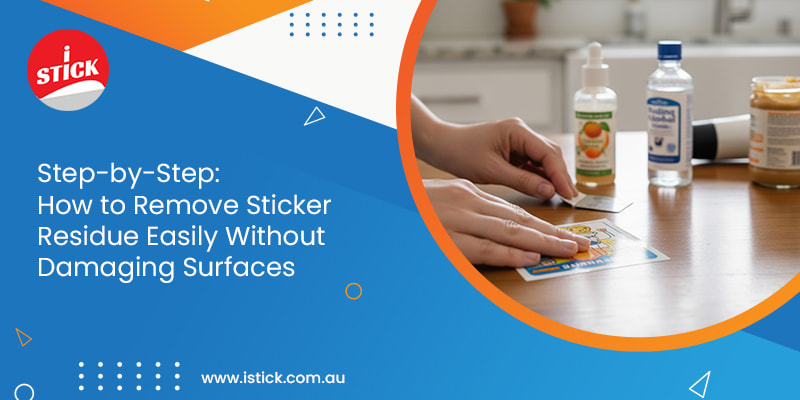
Have you ever peeled off a sticker, whether from a laptop, a glass jar, or a car bumper only to find a sticky residue clinging on like it’s part of the design?
You are not alone. According to a 2023 consumer study, nearly 78% of users reported surface damage or scratches while trying to remove adhesive residues using harsh methods like scraping or chemical cleaners.
The frustration is real and especially when that residue ruins the look or texture of your favorite surface.
Whether it is removable paper stickers, product labels, or decorative decals, the challenge lies not in peeling off the sticker but in removing the sticky residue safely without leaving behind marks or causing surface damage.
Why Does Sticker Residue Stick So Stubbornly?
To remove it effectively, it is important to first understand why sticker residue is so persistent.
Most stickers use pressure-sensitive adhesives (PSAs), a blend of natural or synthetic rubber, tackifiers, and resins that make the sticker adhere firmly on contact.
Over time, heat, moisture, and exposure to air cause the adhesive to polymerize (harden), bonding strongly with the surface beneath.
This is why old stickers or those exposed to sunlight tend to leave behind hard, tacky residues that don’t come off easily with simple rubbing or water.
Step-by-Step: How to Remove Sticker Residue Easily Without Damaging Surfaces
Let’s break this down by surface type because not all materials react the same way to solvents or heat.
Glass, Ceramic, and Metal Surfaces:
These are the most forgiving materials to work with since they are non-porous, residue removal is simple.
Tools You’ll Need:
- Warm water and mild dish soap
- White vinegar or rubbing alcohol
- Microfiber cloth or paper towel
- Plastic scraper or old credit card
Steps:
Soak and soften:
Mix warm water with a few drops of dish soap. Soak a microfiber cloth in the solution and lay it over the residue for 5–10 minutes. This loosens the adhesive.
Wipe or scrape gently:
Use a plastic scraper (never metal) to gently lift the softened residue.
Remove oily film:
If any tackiness remains, apply a small amount of rubbing alcohol or vinegar. Let it sit for 30 seconds, then wipe clean.
Polish:
Finish with a dry microfiber cloth for a streak-free shine.
Avoid using razor blades, as they can scratch glass coatings or leave micro-abrasions.
Wood Surfaces (Finished or Unfinished):
Wood is delicate, especially if varnished or painted. The goal here is to break down the adhesive without stripping the surface.
Tools You’ll Need:
- White vinegar or lemon essential oil
- Cotton ball or soft rag
- Mild dish soap solution
Steps:
Test first:
Dab, don’t rub:
Lightly dab the residue with vinegar-soaked cotton. The acid breaks down adhesive bonds.
Wipe clean:
Use a damp cloth with a mild soap solution to remove leftover residue and oil.
Dry completely:
Wipe dry immediately to prevent wood swelling or water marks.
Avoid:
Using alcohol or acetone, they can dissolve varnish or alter color tones.

Plastic Surfaces:
Plastics are tricky since harsh chemicals can cause clouding or surface etching. Always go mild.
Tools You’ll Need:
- Warm soapy water
- Baking soda paste (baking soda + water)
- Rubbing alcohol (for stubborn cases)
Steps:
Soften the glue:
Apply warm, soapy water for 10 minutes.
Lift gently:
Use your fingers or a plastic card to peel the softened glue..
Apply baking soda paste:
This acts as a mild abrasive to remove the remaining stickiness.
Final clean:
Wipe with rubbing alcohol only if needed, just a few drops on a cloth, not directly on plastic.
Pro Tip:
Avoid nail polish removers, they often contain acetone that can warp or discolour plastics.
Fabric or Upholstery:
Removing sticker residue from fabric can be challenging but possible without damage.
Tools You’ll Need:
- Ice cubes
- Dull knife or spoon
- Rubbing alcohol or vinegar solution
Steps:
Freeze the adhesive:
Rub ice cubes in a plastic bag over the sticky area. Once hardened, gently scrape off the residue.
Dab with alcohol or vinegar:
Lightly blot the spot with a vinegar-water mix (1:1) or a few drops of rubbing alcohol.
Rinse and wash:
Wash as per fabric care instructions to remove odor and traces.
Avoid:
Scrubbing or using hot water as it melts adhesives deeper into the fibres.
Electronic Devices (Laptops, Phones, and Screens):
TThe golden rule here is no liquid seepage, even a drop can damage internal circuits.
Tools You’ll Need:
- Isopropyl alcohol (70%)
- Microfiber cloth
- Plastic card
Steps:
Peel gently:
Remove as much sticker as possible with your fingernail or card.
Dab alcohol carefully:
Apply a few drops of isopropyl alcohol to the cloth, not directly on the device.
Wipe in circular motion:
Work slowly until the sticky residue disappears.
Never use acetone or household cleaners, they can remove screen coatings or dull metal finishes.
DIY Natural Alternatives That Work
If you prefer chemical-free solutions, here are some effective homemade options:
Baking Soda + Coconut Oil Paste:
Ideal for glass and metal. Mix 1:1 ratio, apply, and wait 10 minutes before wiping clean.
Vinegar + Lemon Juice:
Excellent for wood or kitchen surfaces—naturally dissolves adhesive polymers.
Eucalyptus or Tea Tree Oil:
Safe for most hard surfaces and leaves a pleasant aroma while cutting through residue.
These natural methods are eco-friendly and surface-safe, aligning with iStick’s approach to sustainable, user-friendly sticker innovation.
Common Mistakes to Avoid
Even the right intention can go wrong with the wrong tool or method. Here’s what not to do:
Don’t use metal blades:
they scratch, especially on plastic and glass.
Avoid acetone on painted or coated surfaces:
it strips the finish instantly.
Don’t rush:
adhesive removal requires patience; aggressive scrubbing causes micro-damage.
Never mix cleaning agents:
combining alcohol and bleach or vinegar and hydrogen peroxide can release harmful fumes.
The Preventive Solution: Use Removable Stickers
Why go through all this effort when you can avoid sticky residue in the first place? That’s where removable stickers come in like those from iStick.
Removable stickers are designed using low-tack adhesives that provide strong adhesion during use but can be peeled off cleanly without leaving behind sticky traces. Perfect for laptops, packaging, jars, and décor items, they maintain surface integrity while giving users flexibility.
Here’s why iStick removable paper stickers stand out:
Residue-free removal:
Designed with precision adhesive chemistry.
Surface-safe:
Suitable for glass, wood, plastic, and metal.
Environmentally conscious:
Made with recyclable, solvent-free materials.
Durability:
Adheres strongly when needed, peels off cleanly when not.
So, next time you need a sticker for branding, labeling, or organizing—choose a smarter, cleaner option.
Final Thoughts
Removing sticker residue doesn’t have to be a battle between cleanliness and surface safety. With the right methods and understanding what each surface needs, you can remove even the stickiest adhesives effortlessly and safely.
And if you’d rather not deal with the mess again, start with stickers that are designed for clean removal. iStick’s removable stickers make life easier for both individuals and businesses who care about neatness, aesthetics and surface protection.
Because at the end of the day, the best residue is no residue at all.
